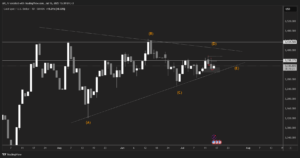
The Flash Crash
Monday saw European shares taking a sharp tumble in what is known as a “flash crash”.
A “flash crash” is an extremely rapid drop in the price of one or more assets, usually followed by an immediate rebound. By the end of the trading day, the market recovers to the point where it’s as if the crash never happened. Most often, flash crashes are the result of human error – commonly termed a “fat finger” error – or they may happen because of computer and algorithms glitches. The “fat finger” error happens when a trader accidentally misclicks a keyboard button when inputting data, such as adding by mistake an extra zero to an order. The most famous flash crash in recent years occurred in 2010 when the Dow Jones plunged around 9% in a matter of minutes, with $1 trillion in equity being wiped out before the market regained 70% by the end of the day.
The Flash Crash on May 2nd
Following the flash crash on Monday morning, US banking giant Citigroup released a statement later during the day where they took responsibility for the market plunge – “This morning one of our traders made an error when inputting a transaction. Within minutes, we identified the error and corrected it.” However, the five minutes wreaked havoc throughout Europe; Nordic shares were hit the hardest with the OMX Stockholm 30 Index plunging 8% before recovering most of the losses shortly after, closing the session 1.9% below the open. Further, the main European index dropped as much as 3%, with €300 billion ($315 billion) evaporating at one point. For Guillermo Hernandez Sampere, head of trading at asset manager Manfred Piontke Vermoegensverwalt EK, it was “the worst day possible for this to happen,” as various public holidays throughout the globe left stock markets with considerably less liquidity than normal, thus giving the remaining trades a greater possibility of moving prices.

The incident revived longstanding concerns about how large financial firms can avoid the occurrence of such errors, and whether the precautions they have in place are adequate. But as Oliver Scharping, a portfolio manager at Bantleon, comments “The reality is that, despite all the fancy control systems, large parts of trading are still manual and human-driven, meaning the ‘fat finger’ isn’t just a metaphor.”
Overall, Monday’s sessions closed sharply lower, whereas on Tuesday the pan-European Stoxx 600 still traded marginally lower as markets worldwide await decisions regarding interest rates.
Disclaimer: This article is not investment advice or an investment recommendation and should not be considered as such. The information above is not an invitation to trade and it does not guarantee or predict future performance. The investor is solely responsible for the risk of their decisions. The analysis and commentary presented do not include any consideration of your personal investment objectives, financial circumstances, or needs.




